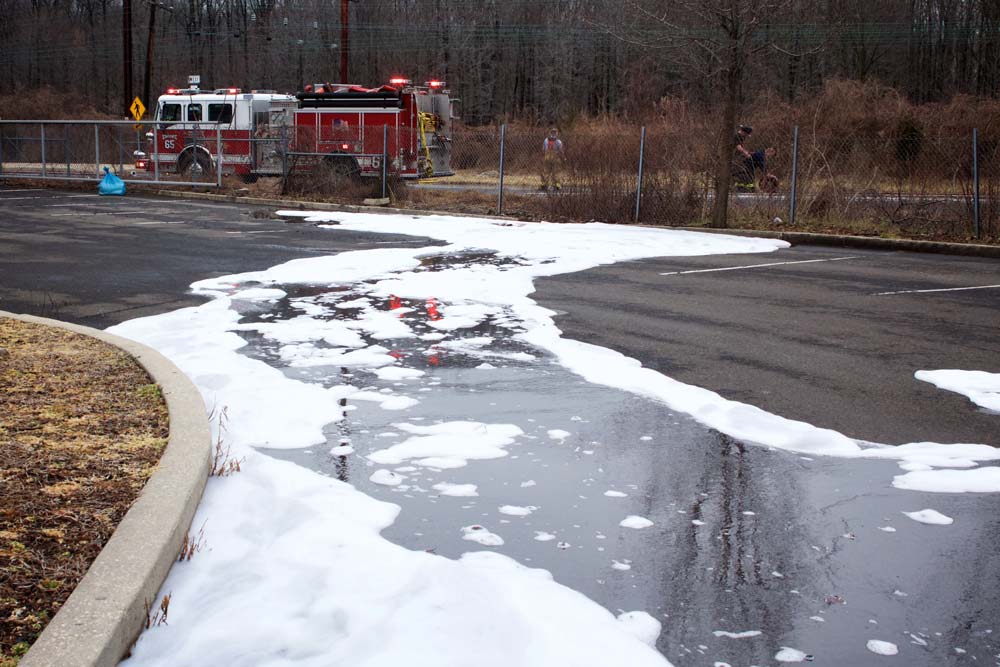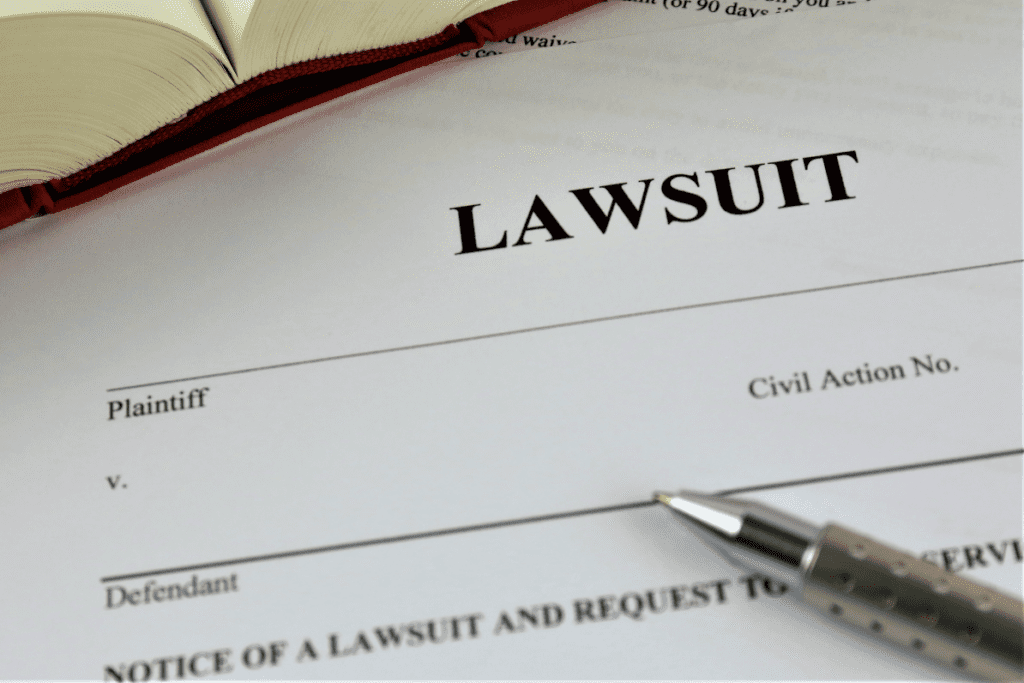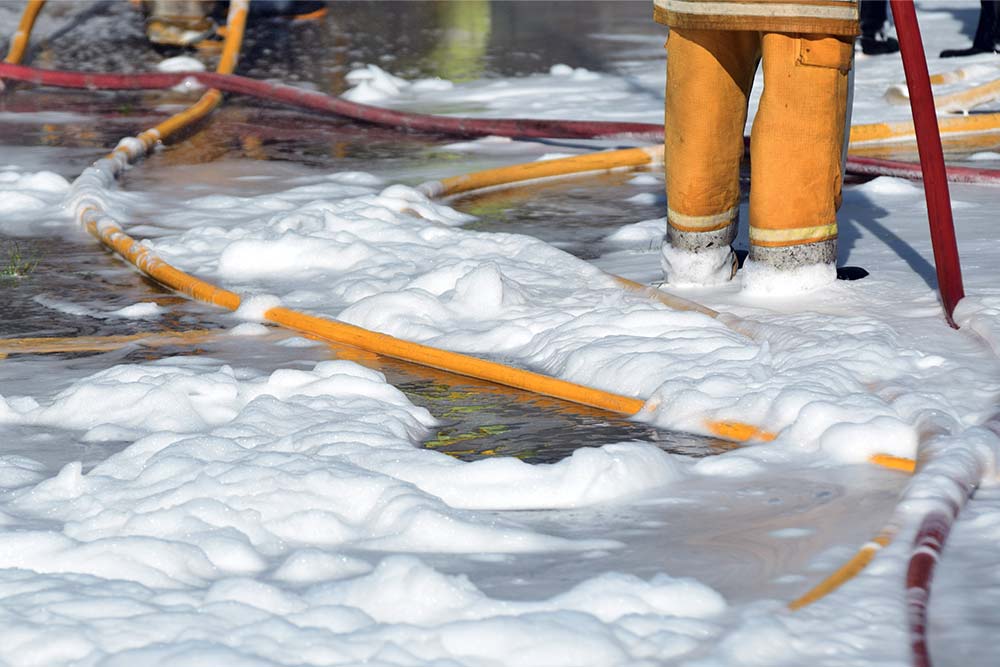Aqueous Film-Forming Foam (AFFF) is a powerful fire suppressant that’s effective against flammable liquid pool fires. The foam is popular with firefighters because it forms a barrier between oxygen and fire, almost instantly extinguishing the fire.
However, AFFF firefighting foam contains toxic PFAS chemicals that can cause different types of cancer. Per- and Polyfluoroalkyl (PFAS) chemicals got the name “forever chemicals” because they don’t break down in the body or environment.
Regular use of these foams led to PFASs leaking into the local water supplies and environment near facilities where AFFF is common. These chemicals accumulate in the body, causing various cancers, especially testicular cancer.
The goal of AFFF Fire Fighting Foam lawsuits is to hold manufacturers responsible for risking the health of millions of people. If you or your loved one received a cancer diagnosis after prolonged exposure to AFFF, you could pursue legal action against the negligent manufacturers.
Join the Many connects people like you with experienced AFFF attorneys to fight on your behalf.
What is AFFF Foam?

AFFF Fire Fighting Foam mixes with water, forming an aqueous film that cuts off oxygen from the fire to extinguish it and prevent re-ignition.
The DOD uses AFFF on aircraft and ships because the presence of munitions, people, and fuel makes fires more dangerous. You can mix these foams with water to form an aqueous film that cuts off a fire’s source of oxygen, extinguishes it, and stops it from reigniting.
AFFF products are standard in facilities such as:
- Fire departments
- Airports
- Offshore oil rigs
- Bulk fuel storage centers
- Chemical manufacturing plants
- Bus and truck fleets
- Military bases
- Gas refineries
Although AFFF is exceptionally effective against dangerous flammable liquid fires, studies revealed it comes at a high cost. The chemicals in the foam have contaminated the environment for decades and caused various cancer types and health issues.
History of AFFF

AFFF has synthetic chemicals called PFAS, including the two most common types; perfluorooctanesulfonic acid (PFOS) and perfluorooctanoic acid (PFOA).
Initially, manufacturers produced PFAS for the Manhattan Project, which would build nuclear bombs for World War II. The manufacturing process involved using Fluorine gas to separate uranium.
Fluorine gas is the most electronegative and reactive of all elements, and so Minnesota became ground zero for PFAS contamination.
In 1950, 3M company acquired the Minnesota facility to continue producing PFAS. 3M started adding PFAS to AFFF to help contain class B fires. They also sold PFAS to DuPont, which had Teflon, a material that makes non-stick cookware.
PFAS became popular due to its ability to withstand temperatures up to 1,700 degrees. It also has stain and oil-resistant properties, which are ideal for numerous commercial purposes.
Unfortunately, PFAS don’t degrade and remain stable in the environment for years. In the human body, they accumulate in the blood and various organs, causing severe illnesses like cancer and leukemia.
Shockingly, 3M was aware of the devastating health effects of PFAS exposure from the beginning. They actually included this information on the labels of the chemicals sold to DuPont.
DuPont and 3M conducted studies in the 1960s and discovered that exposure to high PFAS levels caused animal health issues. Independent third-party studies also confirmed the findings.
In 1966, the US Food and Drug Administration denied a request by DuPont to add PFAS to food substances. They stated that PFAS could cause liver damage, so it’s evident there was adequate information from the early stages.
They chose to ignore the facts and quash the scientific evidence that showed these chemicals’ actual impacts and toxicity. Although 3M discontinued PFAS manufacture in 2000, they reaped annual profits of nearly one-half a billion dollars in the previous years.
PFAS contamination is a significant issue in the US which led to thousands of lawsuits over this problem. Regular use of AFFF foams near certain facilities caused PFAS to leak into local water supplies and the environment.
In 2016, studies discovered that the groundwater within and near Colorado’s Peterson Air Force Base had high PFAS contamination levels. The base regularly used AFFF to contain fuel fires, ending in groundwater.
You may have seen headlines about PFAS water contamination in areas such as St. Louis and Chicago. Most states banned and phased out AFFF to mitigate its effects.
Manufacturers Facing AFFF Lawsuits

Firefighters use various foam brands to extinguish fires, most of which contain PFAS. Well-known companies and manufacturers facing AFFF lawsuits include:
- 3M Company
- Du Pont De Nemours Inc.
- Chemours Company
- BASF Corporation
- Tyco Fire Products
- Dynax Corporation
- Clariant Corp.
- Fire Products GP Holding, LLC
- Chemicals, Inc.
- Corteva, Inc.
- Buckeye Fire Equipment Company
- Deepwater Chemicals, Inc.
- Nation Ford Chemical Company
- Carrier Global Corporation
- Chubb Fire, Ltd.
- Chemguard, Inc.
- National Foam, Inc.
- Chemdesign Products, Inc.
- Archroma Management, LLC
- UTC Fire & Security Americas Corporation
- Kidde-Fenwal, Inc.
- Amerex Corporation
- Kidde Plc
- AGC Chemicals Americas Inc.
- Arkema, Inc.
- United Technologies Corporation
Overview of Research Findings

Prolonged exposure to AFFF causes various severe life-threatening conditions and illnesses. The Agency for Toxic Substances and Disease Registry (ATSDR) and the Centers for Disease Control and Prevention (CDC) raised concerns about PFAS in the foam.
PFAS are toxic and carcinogenic in the human body and potentially animals. According to the International Agency for Research on Cancer (IARC), PFOA is a class 2B carcinogen. In 2016, the EPA published a health advisory report warning about PFAS. The report stated that PFAS exposure could lead to various cancers and other severe health issues.
The IARC later conducted studies and found that people with regular exposure to PFAS have a higher risk of developing testicular, prostate, and kidney cancer. The CDC and ACS agreed with the findings and labeled PFAS in AFFF foam as a human carcinogen.
Aqueous Film Forming Foam Cancer

Multiple studies link PFAS exposure to particular cancers, including but not limited to the following:
- Testicular cancer
- Bladder cancer
- Prostate cancer
- Rectal cancer
- Breast cancer
- Pancreatic cancer
- Thyroid cancer
- Colon cancer
- Liver cancer
- Kidney cancer
Prolonged PFAS exposure also causes health issues such as:
- Preeclampsia in pregnant women
- High cholesterol levels
- Thyroid disease (PFOS)
- Lower infant birth weight
- Ulcerative colitis
- Immune system issues
- Changes in liver enzymes
In children, PFA exposure can cause:
- Lower antibody response to vaccines
- More asthma diagnoses
- Weakened renal function
- Early-onset of menstruation
- Compromised immunity
- Lipid imbalances
Recalls

Most manufacturers voluntarily phased out PFAS from their products, and the US discontinued PFAS production. PFAS is a class of more than 4000 chemicals.
Maine was the first state to ban products with PFAS, and other states followed suit, including:
- Arizona
- Arkansas
- California
- Colorado
- Connecticut
- Georgia
- Hawaii
- Illinois
- Indiana
- Kentucky
- Louisiana
- Maryland
- Michigan
- Minnesota
- Nevada
- New Hampshire
- New York
- Rhode Island
- Vermont
- Virginia
- Washington
- Wisconsin
The challenge is that some types of PFAS are still available because only some got banned entirely. The new types of PFAS are not safer because they still have the same properties.
PFAS are also non-biodegradable, so they remain in the environment and our bodies for years. Despite the discontinued products, the lingering PFAS still affects people across the US.
The EPA recognized this fact and created a council to protect the environment and public health from the effects of PFAS. The committee created a roadmap to address the PFAS issue from the viewpoint of the US government.
General Physician Sentiment on Aqueous Film Forming Foams

Forever chemicals don’t break down easily in the body and pose significant health risks. Research shows that PFAS can bind with blood or serum proteins and interfere with protein/hormone interactions.
A study by the American Heart Association discovered that middle-aged women with high PFAS levels in the blood are more likely to develop high blood pressure. As Dr. DeLisa Fairweather explains, women reach menopause and experience a dramatic drop in estrogen. This affects the immune response, raising the risk of heart diseases like stroke and atherosclerosis.
Brief Aqueous Film Forming Foam Lawsuit History

AFFF foam lawsuits are not new, but there has been a significant increase over the past few years. In 2010, Minnesota took legal action against 3M for disposing of waste that contaminated the soil and groundwater in the state. The case settled for $850 million in 2018, which went towards natural resource and drinking water projects.
In 2019, over 100 AFFF lawsuits merged into one Multi-District Litigation (MDL 2873), presented before the Federal District Court in South Carolina.
These lawsuits were against companies and manufacturers such as DuPont, 3M, Kidde, and Tyco, involving foam blanket and firefighting foams. They claim that using AFFF foam containing PFAS in areas such as military bases contaminated drinking water supplies and groundwater, posing risks to both human health and environmental protection agency standards.
The MDL aims to minimize the federal district court’s burden by ensuring efficient discovery and faster pre-trial proceedings. MDLs are different from class actions because the cases remain independent. After the pre-trial proceedings, the separate matters return to the original district if the parties don’t agree to a settlement.
The first MDL against AFFF manufacturers was settled in February 2021. ChemDesign Inc., Chemguard Inc., and Tyco Fire Products LP agreed to a $17.5 million settlement with Peshtigo residents in Wisconsin, highlighting the dangers associated with foam concentrate and flammable liquids.
By April 2022, there were more than 2000 open cases before the South Carolina court, and the number keeps increasing. More FAA workers, airport workers, US military members, and firefighters are pursuing legal action daily, addressing the dangers of exposure to dangerous chemicals in class b fires and fire training facilities.
People exposed to contaminated drinking water from local or municipal supplies also have valid cases. If you or a loved one recently received a cancer diagnosis after AFFF exposure, talk to Join the Many about joining the MDL and understanding the implications for human health and the environment.
Damages in Firefighting Foam Lawsuits

Experienced AFFF attorneys assess the damages in every case to determine the appropriate settlement. Damages include a person’s non-economic and economic losses from prolonged exposure to AFFF.
If you have an illness or health condition due to exposure to AFFF fire fighting foam, you can recover damages such as:
- Medical bills, including surgical or physician services, hospitalization, prescription medication, and diagnostic testing
- Physical pain and suffering
- Lost wages when you have to miss work for medical appointments relating to your illness or when you’re too sick to attend work.
- Loss of future earning capacity if your illness is too severe to allow you to work moving forward
- Loss of the enjoyment of life
- Emotional distress
Families that lost loved ones due to illnesses caused by AFFF exposure can receive damages such as:
- Funeral expenses
- Loss of prospective net accumulations
- Loss of services and support offered by the deceased
Join the Many can help you file a wrongful death lawsuit against the responsible AFFF manufacturer for their negligence.
Some of the claims in the open lawsuits include:
- The companies were aware or should have been aware of the potential risks and harmful health effects of exposure to AFFF. There’s evidence that research and studies highlighted these risks in the 1950s and 60s, so they have no excuse.
- These companies did not provide adequate warning to people coming into contact with AFFF foam and the potential health risks.
- The companies marketed AFFF as free of unreasonable risks to the users
- The companies did not provide enough safety warnings about PPE when using AFFF. They also failed to recall their products to minimize the risks voluntarily
What Determines the Settlement Amounts in AFFF Lawsuits?
Some factors that affect the outcome and success of AFFF lawsuits, addressing personal protective equipment, military facilities, and negative health effects, include:
- The level of exposure to toxic PFAS in AFFF foams, including the use of personal protective equipment – For instance, firefighters have higher exposure rates due to regular contact with these toxic substances in military facilities and other environments where AFFF formulations are used.
- The severity of the cancer diagnosis and the type of cancer, considering the potential negative health effects associated with exposure to fluorine-free foams and other flammable liquids.
- Cost of current medical bills, including chemotherapy, radiation, surgery, and expert consultations, addressing both environmental concerns and health concerns associated with AFFF exposure.
- The estimated cost of recurring or future medical treatments, including surgeons, psychologists, nutritionists, and physical therapists, taking into account the ongoing environmental concerns and health risks posed by AFFF.
- Punitive damages to punish the responsible company for the injuries and losses related to toxic substances and AFFF formulations.
Although these factors contribute to the settlement amount, each case is different. Past outcomes don’t always guarantee future results, and the complexities of dealing with other flammable liquids and AFFF formulations require careful consideration.
The Battle is Not Yours Alone; You Have a Support System
If you or anyone close to you received a cancer diagnosis after exposure to PFAS in AFFF foam, you have a right to hold the manufacturers responsible. You deserve compensation for your pain and suffering, medical expenses, and other injuries you suffered as a result, especially considering the negative health effects and environmental concerns associated with AFFF.
Although no amount of money can reverse your pain, the compensation will reduce your financial worries. You can seek the quality treatment you need and have a better quality of life for your loved ones, addressing both health concerns and environmental concerns associated with AFFF exposure.
At Join the Many, we believe in fighting for people like you against big corporations that try to avoid taking responsibility for their negligence and the use of toxic substances in AFFF.

